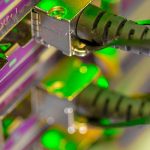Pipelining is how a computer processor breaks down instruction execution into different stages. Think of it like an assembly line in a factory, where multiple tasks happen at once. Pipelining allows several instructions to be in various stages of execution at the same time, making the process more efficient.
Imagine a car factory. Without an assembly line, the factory can only work on one car at a time. With an assembly line, different stations can tackle different tasks on various cars simultaneously—one station installs engines while another adds doors, and yet another paints. This approach boosts car production significantly.
In computing, the processor executes instructions much like that car factory. Take the instruction “add A and B and store the result in C.” First, the processor grabs values A and B. The arithmetic-logic unit (ALU) adds them, while the memory management unit (MMU) stores the result in C. While that addition happens, the MMU can start fetching the next operation, which could be retrieving a different value.
Pipelining structures the processing task into distinct stages. As new instructions enter the pipeline, completed tasks exit at specified intervals. The processor can handle multiple tasks based on their complexity, making the overall process quicker.
So how does it work? Without pipelining, a processor fetches an instruction from memory, executes it, then moves to the next one, leaving some components sitting idle. This causes delays. With pipelining, while one instruction is being executed, the next can be fetched and stored in a nearby buffer, keeping the processor busy.
Each task breaks down into smaller subtasks. Each subtask goes through its own phase in the pipeline, passing its output along to the next subtask until everything’s completed. Every segment in the pipeline has an input register that holds the data, and a combinational circuit that performs the necessary operations.
There are two primary types of pipelines:
-
Instruction Pipeline: Here, instructions move through stages like fetching, buffering, decoding, and executing. Different segments read from memory simultaneously, boosting system throughput. The process becomes more efficient when instruction cycles divide into equal-time segments.
- Arithmetic Pipeline: This handles the various parts of arithmetic operations like multiplication or floating-point calculations, breaking them down for overlapping execution. Intermediate results are stored in registers for each stage to use.
The main advantage of pipelining is better efficiency. It reduces the processor’s cycle time and allows more instructions to be processed at once. Even though it doesn’t shrink the time needed for a particular instruction—since that’s reliant on size and complexity—it significantly increases overall throughput. Pipelined processors often run at higher speeds, creating a more reliable and effective system.
However, pipelining isn’t without its challenges. Issues like data dependencies arise when one instruction waits for the output of another. This can stall the pipeline, causing delays. Branching instructions are tricky too; if an instruction depends on the results of a previous one that hasn’t completed, the processor can stall because it doesn’t know which instruction to execute next.
Other complications include timing variations and data hazards, where multiple instructions vie for the same data. Interrupts can also disrupt the instruction flow.
Security is another aspect to consider. Since pipelining keeps lots of data moving at once, there’s potential for unauthorized access. Attacks like Spectre and Meltdown show how vulnerabilities can be exploited, allowing attackers to access sensitive data stored within the pipeline.
To boost speed even further, there are techniques like superpipelining and superscalar pipelining. Superpipelining divides the pipeline into shorter stages, accelerating instruction processing since each stage can complete its task more quickly. Superscalar pipelining involves running multiple pipelines in parallel, allowing the processor to handle multiple instructions at once.
Pipelining isn’t just for CPUs; GPUs use it too, albeit differently based on their design. CPUs tend to have deep, multi-stage pipelines optimized for a variety of tasks and support for branch prediction. In contrast, GPUs have a greater number of processing units, focus on graphics processing, and usually employ shallower pipelines without focusing on branch prediction.
Pipelining appears across many domains, not just computing. The concept also shows up in data pipelines, sales pipelines, and several other areas.








